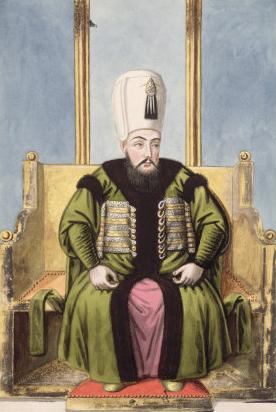<Back to Index>
- Philosopher George Henry Lewes, 1817
- Painter George Clausen, 1852
- Sultan of the Ottoman Empire Ahmed I (Bakhti), 1590
PAGE SPONSOR

Ahmed I (Ottoman Turkish: احمد اول) or Ahmed Bakhti (April 18, 1590 – November 22, 1617) was the Sultan of the Ottoman Empire from 1603 until his death in 1617.
Ahmed I's mother was Valide Sultan Handan Sultan, an ethnic Greek who was originally named Helena. He was born at Manisa Palace. He succeeded his father Mehmed III (1595 – 1603) in 1603 at age 13. He broke with the traditional fratricide and sent his brother Mustafa to live at the old palace at Bayezit along with their grandmother Safiye Sultan. He was known for his skills in fencing, poetry, horseback riding, and fluency in numerous languages.
He was married twice, to Valide Sultan Mahfiruze Hatice Sultan, originally named Maria, a Greek, mother of Osman II, and to Valide Sultan Kadinefendi Kösem Sultan or Mahpeyker, originally named Anastasia, a Greek, mother of Murad IV and Ibrahim I. He also had two sons named Bayezid and Suleiman.
A half - brother of Ahmed, Jahja, resented his accession to the Ottoman throne in 1603, and spent his life scheming to become Sultan.
In the earlier part of his reign Ahmed I showed decision and vigor, which were belied by his subsequent conduct. The wars which attended his accession both in Hungary and in Persia terminated unfavourably for the empire, and its prestige received its first check in the Treaty of Zsitvatorok, signed in 1606, whereby the annual tribute paid by Austria was abolished. Georgia and Azerbaijan were ceded to Persia by the treaty of Nasuh Pasha in 1612.
Ahmed was a poet who wrote a number of political and lyrical works under the name Bahti. But while supportive of poetry, he displayed an aversion to artistry and continued his father's neglect of miniature painting. This was connected to a devout religiosity that declared depiction of living things in art an immoral rivalry to Allah's creation. Accordingly, Ahmed spent his wealth instead on supporting the works of scholars, calligraphers and pious men. Hence he commissioned a book entitled The Quintessence of Histories to be worked upon by calligraphers, but forbade its illustration by the by-now largely dissolved Society of Miniaturists. He also attempted to enforce conformance to Islamic laws and traditions, restoring the old regulations that prohibited alcohol and he attempted to enforce attendance at the Friday Mosque prayers and paying alms to the poor in the proper way.
He was responsible for the destruction of the musical clock organ that Elizabeth I of England sent to the court during the reign of his father. The reason for this may have been Ahmed's religious objection to figurative art or the fact that the complex organ served as a daily reminder of the waxing influence and power of the West.
Ahmed I died of typhus in 1617.
Today Ahmed I is remembered mainly for the construction of the Sultan Ahmed Mosque (also known as the Blue Mosque), one of the masterpieces of Islamic architecture. The area in Istanbul around the Mosque is today called Sultanahmet. He died at Topkapı Palace in Istanbul and is buried in a mausoleum right outside the walls of the famous mosque.